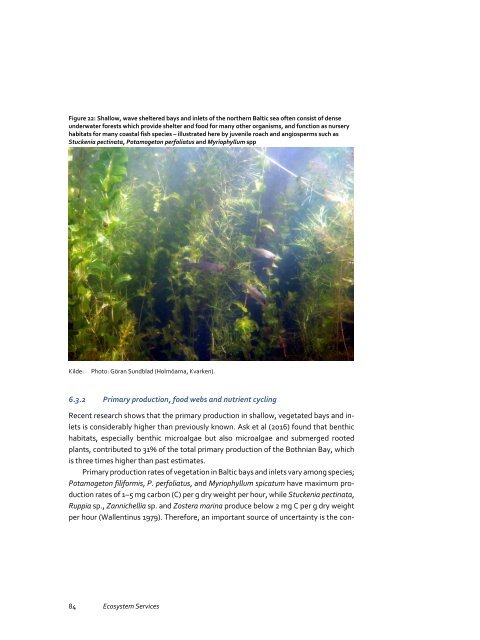Ecosystem Services
FULLTEXT01
FULLTEXT01
Create successful ePaper yourself
Turn your PDF publications into a flip-book with our unique Google optimized e-Paper software.
Figure 22: Shallow, wave sheltered bays and inlets of the northern Baltic sea often consist of dense<br />
underwater forests which provide shelter and food for many other organisms, and function as nursery<br />
habitats for many coastal fish species – illustrated here by juvenile roach and angiosperms such as<br />
Stuckenia pectinata, Potamogeton perfoliatus and Myriophyllum spp<br />
Kilde:<br />
Photo: Göran Sundblad (Holmöarna, Kvarken).<br />
6.3.2 Primary production, food webs and nutrient cycling<br />
Recent research shows that the primary production in shallow, vegetated bays and inlets<br />
is considerably higher than previously known. Ask et al (2016) found that benthic<br />
habitats, especially benthic microalgae but also microalgae and submerged rooted<br />
plants, contributed to 31% of the total primary production of the Bothnian Bay, which<br />
is three times higher than past estimates.<br />
Primary production rates of vegetation in Baltic bays and inlets vary among species;<br />
Potamogeton filiformis, P. perfoliatus, and Myriophyllum spicatum have maximum production<br />
rates of 1–5 mg carbon (C) per g dry weight per hour, while Stuckenia pectinata,<br />
Ruppia sp., Zannichellia sp. and Zostera marina produce below 2 mg C per g dry weight<br />
per hour (Wallentinus 1979). Therefore, an important source of uncertainty is the con-<br />
84 <strong>Ecosystem</strong> <strong>Services</strong>


